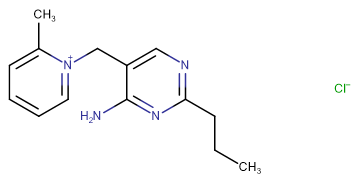
Amprolium
CAS No. 121-25-5
Amprolium ( Amprolium )
产品货号. M10792 CAS No. 121-25-5
氨丙啉是一种用于家禽的球虫抑制剂,是一种硫胺素类似物,通过阻断硫胺素摄取来阻断艾美耳球虫的硫胺素转运蛋白,从而阻止碳水化合物的合成。
纯度: >98% (HPLC)
 COA
COA
 Datasheet
Datasheet
 HNMR
HNMR
 HPLC
HPLC
 MSDS
MSDS
 Handing Instructions
Handing Instructions
| 规格 | 价格/人民币 | 库存 | 数量 |
| 100MG | ¥405 | 有现货 |


|
| 200MG | ¥591 | 有现货 |


|
| 500MG | 获取报价 | 有现货 |


|
| 1G | 获取报价 | 有现货 |


|
生物学信息
-
产品名称Amprolium
-
注意事项本公司产品仅用于科研实验,不得用于人体或动物的临床与诊断
-
产品简述氨丙啉是一种用于家禽的球虫抑制剂,是一种硫胺素类似物,通过阻断硫胺素摄取来阻断艾美耳球虫的硫胺素转运蛋白,从而阻止碳水化合物的合成。
-
产品描述Amprolium? is a coccidiostat used in poultry, is a thiamine analogue and blocks the thiamine transporter of Eimeria species by blocking thiamine uptake it prevents carbohydrate synthesis.
-
体外实验——
-
体内实验——
-
同义词Amprolium
-
通路Others
-
靶点Other Targets
-
受体thiamine
-
研究领域Infection
-
适应症——
化学信息
-
CAS Number121-25-5
-
分子量278.79
-
分子式C14H19N4·Cl
-
纯度>98% (HPLC)
-
溶解度Water: 10 mM
-
SMILESCC1=CC=CC=[N+]1CC2=CN=C(CCC)N=C2N.[Cl-]
-
化学全称2-Picolinium, 1-((4-amino-2-propyl-5-pyrimidinyl)methyl)-, chloride
运输与储存
-
储存条件(-20℃)
-
运输条件With Ice Pack
-
稳定性≥ 2 years
参考文献
1.Iqbal A, et al. J Parasit Dis. 2013 Apr;37(1):88-93.
产品手册




关联产品
-
CK2-IN-1 B
CK2-IN-1 是 CK2 抑制剂,其 IC50 值为150 nM。
-
gp100 (619-627)
gp100 (619-627)
-
Sibiricaxanthone B
Sibiricaxanthone B 是从远志中分离出来的氧杂蒽酮。



 021-51111890
021-51111890 购物车()
购物车()
 sales@molnova.cn
sales@molnova.cn







